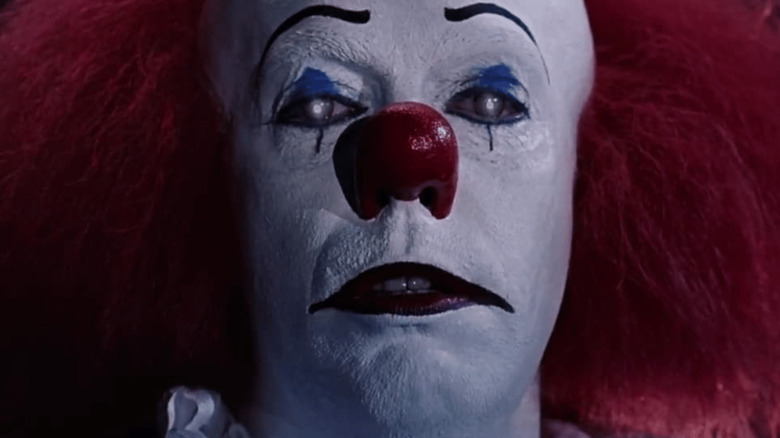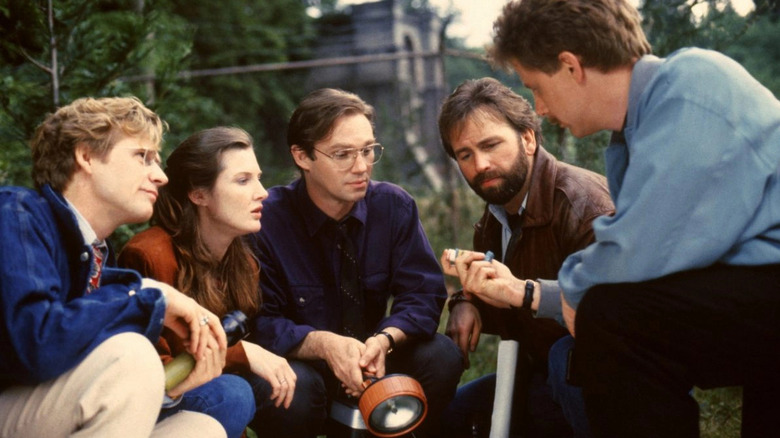Adapting Stephen King's It For TV Gave ABC Plenty Of Reason To Worry
Stephen King's 1986 novel "It" contains a whole lot of story. Over its 1100+ pages, it recounts a battle between children and an ancient, malevolent entity known sometimes as the title's name. At other times, "It" is a werewolf, a mummy, a leper, and most famously, Pennywise the Dancing Clown – whatever its child-target fears the most. As such, the seven kids – known amongst each other as The Losers Club – each have storylines dedicated to their interior lives and how it informs each individual fear. Any adaptation is bound to be lengthy.
When the time came to adapt the behemoth work into what would become the 1990 ABC miniseries, ambitions were high on the filmmaking side of it; at one time we could have had the Godfather of Horror, George Romero, taking the reins before "Halloween III" director Tommy Lee Wallace landed the gig. As "It" screenwriter Larry Cohen tells Yahoo in an oral history of the miniseries, the enthusiasm was less intense on the network side. Cohen recalls:
"ABC was always nervous about 'It,' primarily the fact that it was in the horror genre, but also the eight-to-ten hour commitment. They loved the piece, but lost their nerve in terms of how many hours they were willing to commit. Eventually, they were agreed to a two-night, four-hour commitment and at that point, a couple of things happened. George dropped out, primarily because he had a scheduling conflict, but truthfully I think getting only four hours instead of eight took the magic out of the project for him. And then the original producers left — while still retaining their producer credits — and another set came aboard, and the production moved to Vancouver. At the point that we met with Tommy to direct the series, we were at four hours."
We could've had eight hours of Romero's It
While it would have been fantastic to get an eight-to-ten-hour miniseries — Andy Muschietti's two-part feature adaptation amounted to just over five hours, all told — ABC's jumpiness prevented the sprawling, comprehensive retelling that storytellers like Romero wanted to take on. In some respects, it's for the best; depicting the novel's Ritual of Chüd is an uphill battle for any filmmaker.
When Wallace, who hadn't read the book, came on board "It" as director, he wasn't quite satisfied with the second part of the miniseries on the page and later dove in on the rewrite himself, hence the double writing credit. Wallace expands to Yahoo:
"Things were great at first: Larry's script for Night 1 was just wonderful, well organized and cleverly structured into seven parts for seven characters. His script for Night 2 wasn't nearly as successful, in my opinion. For reasons of his own, he had completely moved away from the plotting of the book, and created a much smaller story, a very interior melodrama focusing on Beverly's husband as the ultimate bad guy. I wasn't happy with it at all, but Larry didn't show much enthusiasm for a big rewrite. I asked him to come to Vancouver and work with me on the script for Night 2, but he declined. With little other choice, I turned to the best writer I could get for no money — myself. The rewrite better reflected the basic plot of the book, or as much as a radical condensation would allow."
King, for his part, stayed hands-off in the process. While Muschietti's films are considered the superior adaptation these days, Tim Curry's Pennywise still strikes fear in this millennial writer's heart.

